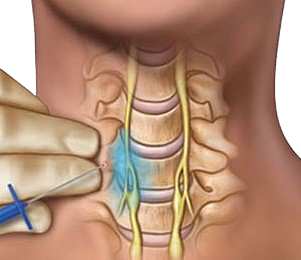Dr. Eugene Lipov, a Chicago based chronic pain physician come across the correlation of when treating chronic pain patients, their post-traumatic stress disorder also began to resolve.
Post-traumatic stress disorder (PTSD) is defined by the Diagnostic and Statistical Manual of Mental Disorders (DSM-5) as a pathologic trauma and stressor disorder that occurs following exposure to severe trauma. Lebovitz et al. first described the use of stellate ganglion block (SGB) to treat PTSD in 1990.
Lipov, has further developed the use of Stellate Ganglion Block (SGB). It restores the “fight or flight” portion of the brain to its pre-trauma state. Simply put, PTSD is an injury to the sympathetic nervous system that renders it overactive and very sensitive. Once this injury is properly treated, then PTSD symptoms vanish, sometimes in under one hour.
Who Is A Candidate For This Procedure?
How Does It Work?
An anaesthetic mixture is injected into one or two nerve bundles found on the right side of the neck. The injection(s) “reboot” the sympathetic nervous system, much in the same way computers are restarted to restore normal function.
How Long Does It Take?
The procedure takes 5-10 minutes to be administered. The patient is the evaluated on the efficacy of the Horner’s effect. If a major improvement in the patient’s well being has not occurred , then a second injection is performed in the higher part of the neck, within 30mins of the first procedure. The patient is observed and typically leave the practice within 1-2 hours of arrival.
Is The Block Procedure Proven?
Dr. Eugene Lipov has performed over 600 SGB to date. Dr. Sean Mulvaney has performed approximately 2500 Stellate Ganglion Block (SGB) procedures to date with good results. The SGB for PTSD/PTSI has recently been featured on 60 Minutes.
Is The SGB Procedure TGA Approved?
No, the TGA have not yet evaluated the success of the SGB to treat PTSD. However, the procedure of a local anaesthetic injection into the nerve bundle in the neck has been in use worldwide since 1925 to treat chronic pain. Dr Lipov was the first to identify PTSD as another indication for its use. “Off-label uses of approved procedures is common in medicine allowing practitioners to discover additional applications.
Does The SGB Procedure Always Work?
Most recent literature indicateds the procedures were successful 85% of the time.
Is The SGB Procedure a Cure for PTSD?
No. It is not entirely a cure, but symptoms such as anxiety, hyperarousal, nightmares and night terrors can be greatly reduced or eliminated almost immediately. Because PTSD is an injury it can recur in the event of subsequent trauma(s).
How many Procedures are typically needed?
Every patient is different, two to three procedures may initially be needed and the patient is the reviewed. The longest followed patient had two procedures in 10 years.
Do Patients Require Ongoing Care After the Procedure.
In many cases, yes. After SGB psychological treatments can be much more effective. Many patients have been suffering with PTSD issues for many years, so some guidance to allow them to resume meaningful, productive lives is often necessary. We do try to assist in finding the right support for your PTSD and recovery process.
Do Health Funds Cover the Cost?
Currently, health insurance, including Medicare, does not cover SGB Procedures for PTSD. Eventually, this may change as more and more research continues the procedures effectiveness.
